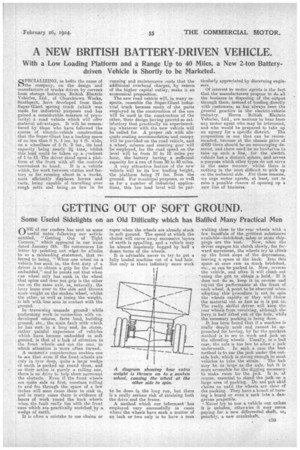GETTING OUT OF SOFT GROUND.
Page 23

If you've noticed an error in this article please click here to report it so we can fix it.
Some Useful Sidelights on an Old Difficulty which has Baffled Many Practical Men
0"of our readers has sent us some useful notes following our article . entitled, "Getting Out of Tight Corners," which appeared in our issue dated January 8th. Be commences his letter by pointing out wheat he alludes to as a misleading atateMent, that referred to being " When one wheel on a vehicle has sunk in, the first, duty of a. driver is to obtain a grip for the wheel embedded," and he points out that when cue wheel only has sunk in the wheel that spins and does not grip is the other one on the same axle, as, naturally, the lorry leans over to the side and throws more weight on the sunken wheel, whilst the other, as well as losing the weight, is left with less area in contact with the ground.
In traversing unmade ground:. while performing work in connection with undeveloped estates-, farm land, building ground., etc., the main fault with which he has met in a long and, he states, rather painful experience of vehicles which have, become embedded in soft ground, is that of a lack of attention to the front wheels and not the rear, to -which attention 13 more often turned.
A moment's consideration enables one to we that even if the front wheels are• enly in tyre deep, quite a large wedge of earth is packed up round them, and
as their action is purely a rolling one, there is no drive to help them surmount the obstacle. Even if the front wheels are quite safe at first, constant rolling , to and fro through the space of a few inches will soon cause them to sink in, and in many cases there is evidence of hours of work round the back wheels when the fault really lies with the front ones which are practically scotched, by a -wedge of earth.
It is often a mistake to use chains or rapes when the wheels are already stuck fu soft ground. The speed at which the chains will carve away successive layers of earth is appalling, and a vehicle may be almost hopelessly hogged by half a dozen turns of the wheels.
It is advisable never to try to get a fully loaded machine out of a bad hole. Not only is there infinitely snore work
to he done in the long run, but there is a really serious risk of straining both the drive and the frame.
A method which our informant' has employed very successfully in cases where the wheels have sunk a matter of an inch or two only is to have a man waiting close to the rear wheels with a few handfuls of the grittiest substances available—hrickdust, ashes or stone chip
pings are the best. Now, when the driver engages his clutch slowly, for forward movement, the wheels try to climb up the front slope of the depressions, leaving a space at the back. Into this space at, once ram as much hrickdust, etc., as can be packed in. Now, reverse the vehicle, and often it will climb out -tieing the grit to obtain a hold. If it does not do so, keep it in reverse and met:At the performance at the front of each wheel. A point to be observed when adopting this procedure is not to spin the wheels rapidly, or they will throw the material out as fast as it is put in. The really skilful driver will keep the leas wheels from revolving, although the lorry is half lifted out of the hole, while the necessary pecking is being done.
It has been found that if a machine is really dee-ply sunk and cannot be approached for towing, by far the quickest method is to set to work and jack up the offending Wheels. Usually, in e bad' case, the axle is too hew to allow a jack underneath. Ir. such a case the best method is to use the jack under the outaide hub, which is strong enough in most vehicles to take the strain. • The hub maybe as large as the axle, but it is more accessible for the digging necessary to make room for the sack. It is, of course, essential to' stand the jack on a large area of packing. Do not put skid chains on until the wheels are clear of the packing. They have a knack of turning a board or even a sack into a dangerous projectile.
a Never try to tow a vehicle out unless it is unladen, otherwise it may mean paying for a new differential shaft, or possibly, a new crankshaft.






























